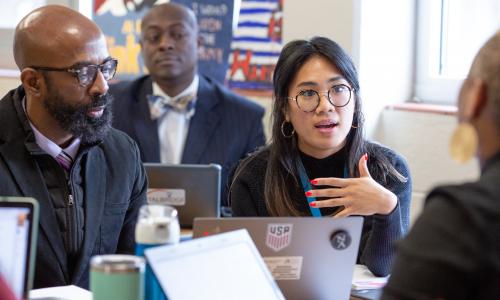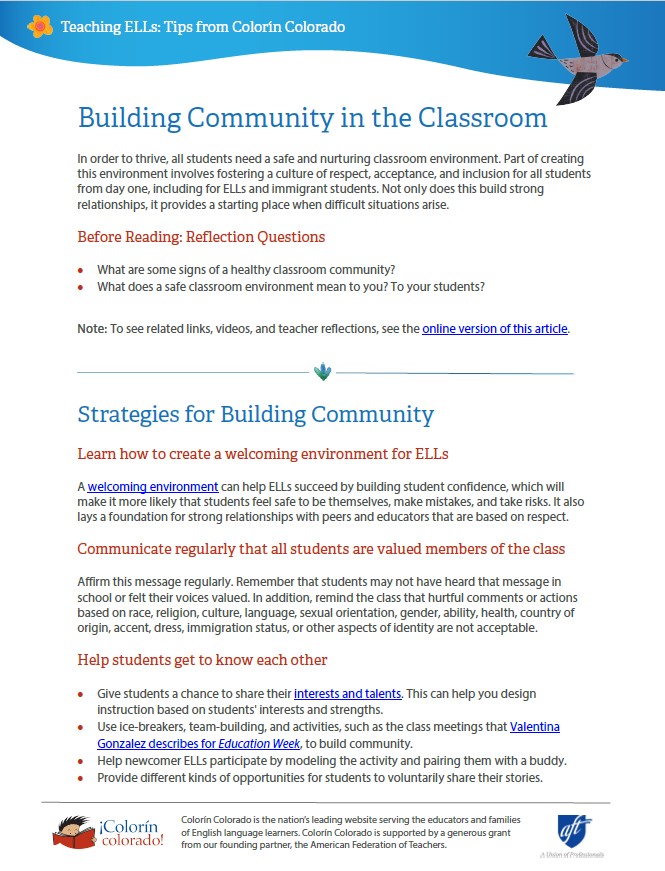Talking About Tough Topics: Tips for Educators

Here are some tips for talking about tough topics and current events when they come up in the classroom. This article is part of Navigating Tough Topics in the Classroom: Tips for ELL Educators.
Photo credit: Photo by Allison Shelley
Acknowledgements
 This project was made possible with support from the American Federation of Teachers.
This project was made possible with support from the American Federation of Teachers.
It is possible that complex, controversial topics will come up in the classroom, either in response to current events or as part of planned instruction.
Here are some tips for navigating these conversations, particularly with your English language learners (ELLs).
 Before Reading: Reflection Questions
Before Reading: Reflection Questions
- What are some topics you may be concerned about discussing in the classroom?
- What skills do I want students to have in dealing with difficult discussions?
- What can I do to prepare for difficult moments or controversy?
- How do I respond to stress and how can I manage stress in the heat of the moment?
Being Prepared
Find out what your resources are
Ask a trusted colleague, administrator, and your local teacher's union what kind of resources are available to help you navigate difficult conversations in the classroom, both from a content perspective and a personnel perspective. Talk with your administrator about successes or problems in the past. Starting the conversation early will help you when a tough topic arises.
Brainstorm possible responses
Consider how you might respond when a tough topic comes up. What are some options you have? What can you do to give students more practice in discussion?
Responding to Current Events
Consider the impact on students
Students may vary in their desire or interest in discussing current events. This is especially critical to remember since ELLs and immigrant students:
- bring their own unique histories, perspectives, and emotions to current events
- may have experienced related traumas
- may be impacted by events that are unfolding in their home countries, such as a natural disaster, political news, unrest, or other significant events.
Don't hesitate to create some space for students to process their thoughts and emotions. For example, after a major event, you could give students a chance to write in journals and tell them that the class will be returning to this topic after you've had time to read the journal entries and create a plan.
The impact of global crises
If you teach students who are impacted by a global crisis:
- Do not put them on the spot to comment on current events.
- Let them know that you are available to talk if needed.
- Talk with family liaisons or others who know their community well to find out how they are responding to current events and what kind of support the school might offer.
- Consider pulling a team together of family liaisons, parents, and mental health professionals to discuss culturally appropriate forms of support.
Plan instruction carefully
If this is an event you will be covering in your instruction:
- First, consider whether the topic is appropriate for discussion in the classroom.
- Do careful research and look for materials from well-established, trustworthy sources.
- Think about your own point of view and possible biases.
- Be well-prepared and anticipate the need to manage discussions on controversial topics.
- Consider the best way to approach the topic so as not to put students on the spot.
- Check in with administrators and your local teacher's union for guidance.
Prepare for classroom discussion
If you are discussing these current events in the classroom (either in a planned or unplanned discussion):
- Remind all students to show respect for each other.
- Refer to guidelines for respectful classroom discussion.
- Reiterate that disrespectful speech/behavior and bullying will not be tolerated.
- Keep in mind that students will bring multiple perspectives about these events.
- Assure students that you will respect their privacy, and that they do not have to share any personal information to participate.
- Look for strategies designed to increase student understanding and dialogue, such as dialogue circles and the activities compiled by Facing History and Ourselves.
- Look for ways to foster students' empathy. (See ideas under the section on "Teaching empathy.")
- Ask colleagues for advice and support where needed.
For additional ideas, see:
- Navigating Tough Topics in the Classroom: Tips for ELL Educators
- Building Bridges Through Storytelling: What Are Your Students' Stories?
Responding to current events
- Creating a Safe Space for Students to Discuss Current Events (Edutopia)
- Current Events in Your Classroom: Ideas for Middle and High School (Facing History)
- The best way to teach current events? Let students lead (KQED)
Ensure ELLs can fully participate in any lesson or discussion
If you proceed with a discussion or lesson plan, ensure you include ELLs by:
- considering how the topic might connect to students' experiences
- teaching important background knowledge, vocabulary, and academic language
- scaffolding the lesson for various levels of proficiency
You can find great ideas for instruction in our ELL Strategy Library.
Teaching Social Studies and History to ELLs
- Social Studies and History Instruction for ELLs: Resource Collection
- Preparing an Engaging Social Studies Lesson for ELLs
- Primary Sources, the Library of Congress and English Learners
Teaching big topics
- What are good strategies teachers can use to explore "controversial" topics? (Ed Week)
- Fostering Civil Discourse: How do we talk about topics that matter? (Facing History)
- Building Perspective Through Meaningful Discussion (Edutopia)
- Journals in a Facing History Classroom (Facing History)
- A Journal Can Be Anything (Teaching Tolerance)
Look for ways to make content relevant
Making connections between students' experiences and the curriculum can provide powerful moments for learning and reflection. At the same time, it's important to proceed with care and sensitivity, evaluating which topics are appropriate for your students at every step.
Teacher Anna Centi, who teaches newcomer students and refugees from Yemen in Dearborn, Michigan, also has found that students are more likely to tackle challenging material if they can relate to it. One book that has resonated with her students is A Long Walk to Water by Linda Sue Park. You can see her students' discussion of the book in the featured video, You Are Welcome Here.
Tips for getting started
Brainstorm ideas with students
- Ask students to brainstorm topics that they would like to study. (This gives them the opportunity to identify topics they feel comfortable exploring.)
- Consider using an inquiry-based or project-based learning approach that allows students to take the lead in identifying a question or problem to solve/research.
Look for local connections
- Look for ways to connect student projects to issues in their own community.
- Identify community assets and resources that you can utilize.
- Look for opportunities to make connections with guest speakers, community members, or local organizations in the community that reflect students' lives and can be used as resources.
- Offer students opportunities to present their work in public, whether to classmates, parents, or community members through presentations, local media, and outreach.
- Encourage students to look for contributions members of their local community have made. (See more on this on idea from Dr. Sandra Duval.)
Topics in the News
Immigration
Talking about immigration may cause extreme anxiety for students. At the same time, immigrant students may welcome the chance to discuss a topic that affects them so directly.
- If you are planning a lesson plan related to immigration (even if in a historic context), proceed with care and extensive planning.
- Recognize that you are not an immigration expert.
- Tell students you are open to their experiences, but any information that students share about immigration policies must be informed by research.
- Consider talking privately with your immigrant students beforehand on whether they feel comfortable with the topic.
- Do not ask students to share their experience directly.
- Never refer to a student's immigration status publicly or privately.
- Remember that all students have a right to a public K-12 education regardless of immigration status.
- Include immigration as a characteristic that is protected against discrimination and bias.
- Be mindful of your language and consider developing a shared list of helpful terms and vocabulary: refugee, asylum, "undocumented" (instead of "illegal"), etc.
- Remind the class that students can discuss the merits of immigration policy while maintaining a respectful tone about the people involved.
Resources
- How Immigration Issues Impact Students
- What Students Do — and Don't Say — About Immigration
- Classroom Resources: Teaching About Immigration
- In “achingly beautiful” letters, students who are learning English share their hopes (The Washington Post)
Incidents related to violence, hate, bias, or racism
There are so many kinds of distressing events in the news for young people to process. It can be difficult to know how and when to discuss current events that students may be learning about in the news, on social media, or from peers. For specific ideas and resources, please see the following resource pages, which are curated and updated by Colorín Colorado.
- 15 Tips for Talking with Children About Violence
- How to Address Bias and Bullying: Resources for Schools
- Responding to COVID Bullying, Bias, and Violence Against Asian Americans
- Addressing Anti-Semitism and Incidents of Hate
- How Schools Can Create a Safe Environment for Muslims
- Talking with Students About Racism and Violence: Resources for Educators
The COVID-19 pandemic
It is important to proceed with sensitivity in discussions of the pandemic. Students may have experienced illness, loss, hardship, or other challenging/traumatic experiences. Keep in mind that your students' experiences will have varied greatly based on their circumstances at home. Learn more about some of the particular challenges ELL and immigrants have faced. For guidance on discussing topics related to the pandemic, see these resources from the National Center for School Crisis and Bereavement.
If you are considering tying the pandemic to learning, consider a student-led inquiry- or project-based approach, such as the activity teacher Keisha Davidson describes below.

